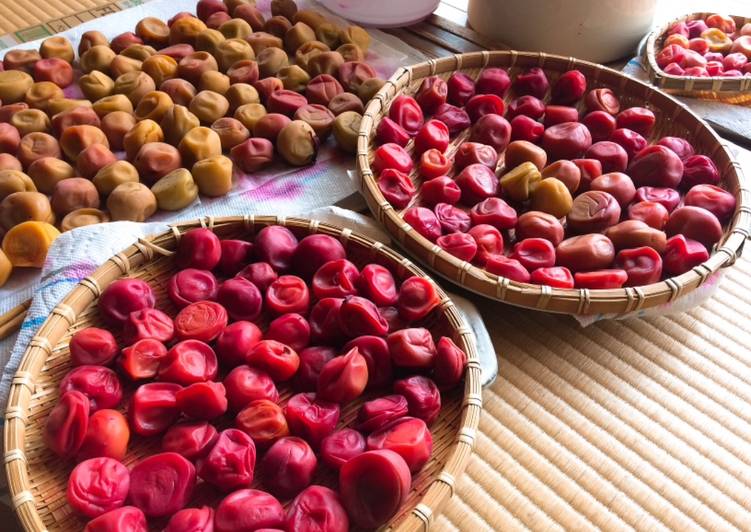Umeboshi- Japanese pickled plums / salt-preserved plums. Great recipe for Umeboshi- Japanese pickled plums / salt-preserved plums. Japanese pickled plums is salt-preserved food. We start making this when you see plums.
 The word umeboshi is often translated into English as 'salted Japanese plums', 'Japanese plums' or 'preserved plums'.
Ume (Prunus mume) is a species of fruit-bearing tree in the genus Prunus, which is often called a "plum", but is actually more closely related to the apricot.
Umeboshi is sour pickled plum and has been eaten for over a thousand years in Japan.
You can Cook Umeboshi- Japanese pickled plums / salt-preserved plums using 4 ingredients and 7 steps. Here is how you cook that.
The word umeboshi is often translated into English as 'salted Japanese plums', 'Japanese plums' or 'preserved plums'.
Ume (Prunus mume) is a species of fruit-bearing tree in the genus Prunus, which is often called a "plum", but is actually more closely related to the apricot.
Umeboshi is sour pickled plum and has been eaten for over a thousand years in Japan.
You can Cook Umeboshi- Japanese pickled plums / salt-preserved plums using 4 ingredients and 7 steps. Here is how you cook that.
Ingredients of Umeboshi- Japanese pickled plums / salt-preserved plums
- What You needis 2 kg of ripe plums.
- What You needis 300 g of salt.
- What You needis 300 g of Red shiso leaves (if you have).
- What You needis 2 Tbs of salt.
Ripened plums are marinaded with salt, sun-dried, and preserved for a couple of months to develop the flavor. Initially, the preserved plums are actually yellow, not the familiar red you typically see Umeboshi. "Umeboshi (梅干し)" is a traditional Japanese pickle made of ripe Ume plums. They are pickled in salt and dried in the sun. They are pickled in salt and dried in the sun.
Umeboshi- Japanese pickled plums / salt-preserved plums instructions
- Wash plums gently, remove hulls with a bamboo stick, and dry well with paper towels one by one. Please make sure the plums are dried well otherwise the moisture of plums will cause growing mold in the jar..
- Place the plums in a clean jar, add the salt and mix well with a sanitized spatula or your hands with gloves on to make sure that inside of the jar is kept clean. Put plastic wrap over the plums (making it stick to the surface of the plums) and put a drop lid or flat plate on the plastic wrap. Then put 4kg weight on the plate. A few days later, you will see some quantity of water may be released from the plums, then reduce the weight to 2 kg. Leave it for a week in cool, dark place..
- One week later, you will see a lot of water released from the plum and find red shiso begins on the market.Remove the stems from the red shiso and wash it. Place the leaves into a bowl, add of salt and rub it with your hands and squeezing the leaves to remove any moisture. Do the same thing again with the last salt..
- Place the leaves into a clean bowl, add 1 cup of plum juice from the jar, mix well and put it back on top of plums in the jar. Put plastic wrap over it again (making the wrap stick to the surface of the shiso leaves) and put back the drop rid or flat plate on. No need to put the weight this time. If the jar has it's own lid, put the lid on..
- When the rainy season is over (a few weeks later from the red shiso is added to the jar), take all the plums and the red shiso leaves out from the jar, place them onto sieves or flat strainer and let them spread over sieves in a single layer. Let them sun dry, from a few hours, up to 3 days..
- Please keep the liquid. we call it ume-zu(plum vinegar) and you can use it for cooking as you use vinegar for your cooking..
- The dried plums should be kept in a sanitized jar with lid and will remain good for many years. Put the dried shiso leaves in a food processor and make it into coarse powder, then it'll be delicious furikake seasonings. (Furikake is toppings for rice. You can sprinkle furikake on your rice).
Characterized by strong acidity and sourness, Ume plums don't become sweet even if they have ripened, so Umeboshi plums are usually quite salty and sour. Umeboshi- those salty pickled wrinkled balls that must be some kind of fruit. they're intimately familiar to Japanese and have been gaining popularity in the U. They have health benefits, and taste great too! Our editors searched Japanese e-commerce sites such as Amazon, Rakuten, and Yahoo! We then picked out the most popular pickled.